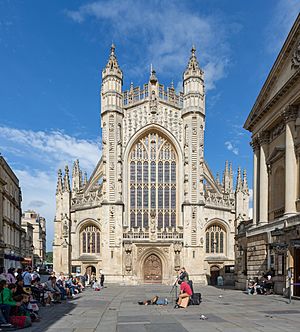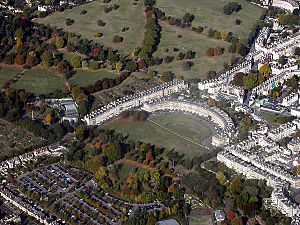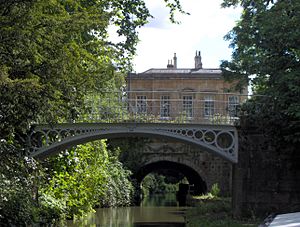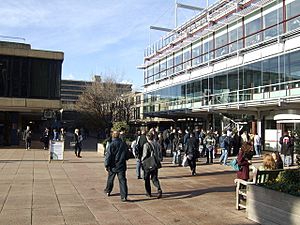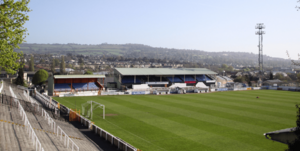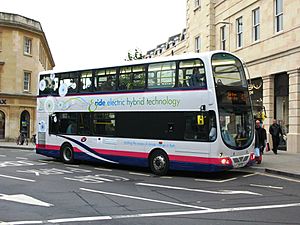Bath, Somerset facts for kids
Quick facts for kids Bath |
|
|---|---|
| City | |
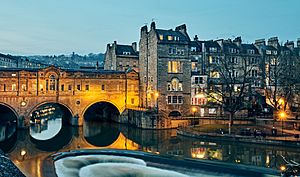 Pulteney Bridge |
|
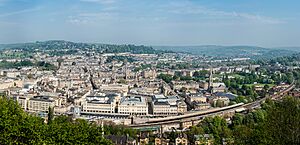 Skyline of Bath city centre with Bath Abbey |
|
| Population | 94,092 (2021 Census) |
| Demonym | Bathonian |
| OS grid reference | ST750645 |
| • London | 97 miles (156 km) E |
| Unitary authority | |
| Ceremonial county | |
| Region | |
| Country | England |
| Sovereign state | United Kingdom |
| Post town | Bath |
| Postcode district | BA1, BA2 |
| Dialling code | 01225 |
| Police | Avon and Somerset |
| Fire | Avon |
| Ambulance | Great Western |
| EU Parliament | South West England |
| UK Parliament |
|
Bath is a city in Somerset, England. It's famous for its Roman-built baths, which is how it got its name! In 2021, about 94,092 people lived there. Bath is located in the valley of the River Avon. It's about 97 miles (156 km) west of London and 11 miles (18 km) southeast of Bristol.
The city became a UNESCO World Heritage Site in 1987. This means it's a very important place culturally, recognized around the world. In 2021, it was also added to a group called the "Great Spa Towns of Europe". Bath is the biggest city in Somerset.
The Romans built baths and a temple here around 60 AD. They called the city Aquae Sulis, which means "the waters of Sulis" (a goddess). People knew about the hot springs even before the Romans arrived. Bath Abbey was started in the 7th century and became a religious hub. It was rebuilt in the 12th and 16th centuries.
In the 17th century, people started believing the spring water could heal them. Bath then became a popular spa town during the Georgian era. Many buildings from this time are made of Bath stone. Famous examples include the Royal Crescent, Circus, Pump Room, and Assembly Rooms. A man named Beau Nash was in charge of the city's social life from 1705 until 1761.
Many streets and squares were designed by John Wood, the Elder. In the 18th century, Bath became very fashionable and its population grew. The famous writer Jane Austen lived in Bath in the early 19th century. More buildings were added in the 19th century and after the Bath Blitz in World War II. Bath became part of the county of Avon in 1974. When Avon was removed in 1996, Bath became the main center of Bath and North East Somerset.
Bath gets over 6 million visitors every year. This makes it one of the most visited English cities by tourists from other countries. People come to see the spas, take canal boat tours, and visit places like the Royal Crescent and Parade Gardens. There are also many shops, theatres like the Theatre Royal, and museums. Some museums include the Museum of Bath Architecture, the Victoria Art Gallery, and the Fashion Museum.
Bath has two universities: the University of Bath and Bath Spa University. Bath College offers other types of education. The city also has sports teams like Bath Rugby and Bath City.
Contents
History of Bath
Ancient Times: Iron Age and Roman Bath
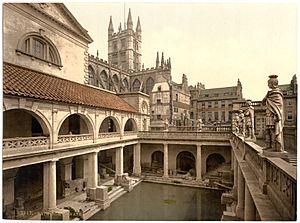
People lived in the hills around Bath, like Bathampton Down, a very long time ago, even in the Mesolithic period. Some Bronze Age burial mounds were found here. Solsbury Hill, which overlooks the city, was an Iron Age hill fort.
Archaeologists believe that the main spring at the Roman baths was a special, sacred place for the ancient Britons. They worshipped a goddess named Sulis. When the Romans arrived, they connected Sulis with their goddess Minerva. That's why the Roman name for the town was Aquæ Sulis, meaning "the waters of Sulis."
Cool fact: Archaeologists found "curse tablets" in the sacred spring. These were metal pieces with messages scratched on them in Latin. People would write curses on them, asking the goddess to punish those who had wronged them, like someone who stole their clothes at the baths!
A temple was built around 60–70 AD, and the bathing complex grew over the next 300 years. Roman engineers used oak piles to create a strong base for the buildings. They also built defensive walls around the town in the 3rd century. After the Romans left in the early 5th century, the baths fell apart and were eventually covered by mud.
In 2012, a huge collection of 30,000 silver Roman coins was found near the Roman baths. This was one of the biggest coin hoards ever found in Britain!
Medieval Bath: Kings and Monasteries
Some people think Bath might have been the site of the Battle of Badon around 500 AD, where King Arthur supposedly defeated the Anglo-Saxons. The West Saxons captured the town in 577. An old Anglo-Saxon poem called The Ruin might describe what the Roman site looked like back then.
A monastery was started early on, possibly by King Osric of Hwicce in 675. By the 9th century, Bath was a royal town. King Alfred redesigned the town. Coins were even made in Bath during the reign of Edward the Elder, with "BAD" on them, which came from the Anglo-Saxon name for the town, meaning "at the baths."
A very important event happened at Bath Abbey in 973: Edgar of England was crowned king of England. This ceremony became the model for all future English coronations.
After a rebellion in 1088, William Rufus gave Bath to a royal doctor named John of Tours. He became the Bishop of Wells and Abbot of Bath. He started building a much larger church, which became his cathedral. New baths were also built around the three springs.
St John's Hospital was founded around 1180. It's one of England's oldest almshouses, providing shelter for the poor and sick near the hot springs. Around 1200, Bath got its first mayor.
Growing Bath: From Spa to Fashionable City
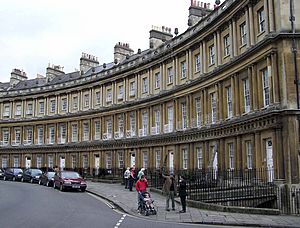
By the 15th century, Bath's abbey church was falling apart. Bishop Oliver King decided to rebuild it in 1500. The new church was finished just before Henry VIII closed down monasteries in 1539. The abbey church was then restored and became the city's main church.
In the Elizabethan era, Bath became popular again as a spa. The baths were improved, and rich people started visiting. Queen Elizabeth I gave Bath a Royal charter in 1590, officially making it a city.
During the English Civil War, Bath was important for King Charles I. But when Parliament's forces arrived, the city surrendered. It was later taken back by royalists after the Battle of Lansdowne in 1643.
A doctor named Thomas Guidott became interested in the healing powers of the waters. In 1676, he wrote a book about Bath's hot waters. This made the city even more famous, and many wealthy people came to try the waters.
More buildings were added during the Georgian era as more visitors needed places to stay. Architects John Wood, the Elder and his son, John Wood, the Younger, designed many new streets and squares. These buildings had identical fronts, making them look grand and classical. Much of the golden-colored Bath stone used for building came from quarries owned by Ralph Allen. He helped improve the postal service in western England.
In the early 18th century, Bath got its first theatre. The Theatre Royal, Grand Pump Room, and assembly rooms were also built. Beau Nash, the "Master of Ceremonies," set the rules for social events in the city. Bath became the most fashionable spa town in Britain, attracting many important visitors.
Modern Bath: War, Restoration, and Today
In 1801, Bath had a population of 40,020, making it one of Britain's largest cities. William Thomas Beckford bought houses in Lansdown Crescent and created a large garden with Beckford's Tower at the top.
During World War II, Bath was bombed by German planes in April 1942. This was part of the "Baedeker Blitz" raids. Over 400 people were killed, and more than 19,000 buildings were damaged or destroyed. Famous places like the Royal Crescent and the Assembly Rooms were burned out. Luckily, most of these buildings have been restored.
After the war, some parts of the city were rebuilt in a modern style, which sometimes clashed with the old Georgian buildings. But people campaigned to protect the historic buildings, and this helped stop further damage. In 1987, Bath was made a World Heritage Site by UNESCO, recognizing its global importance.
Since 2000, Bath has seen new developments like the Thermae Bath Spa, the SouthGate shopping center, and new offices. UNESCO reviewed Bath's World Heritage status in 2009 but decided to let it keep its status. They asked Bath to be careful with new buildings and to try for world-class architecture.
Geography and Environment
Where is Bath?
Bath is in the Avon Valley, surrounded by limestone hills. It's near the edge of the Cotswolds, which is a beautiful natural area. The Mendip Hills are about 7 miles (11 km) south of the city. The highest point in Bath is 781 feet (238 meters) on the Lansdown plateau. Bath covers an area of about 11 square miles (28 square km).
The River Avon flows through Bath. The city center is about 82 feet (25 meters) above sea level. The river used to flood often, but major flood control projects in the 1970s helped stop this. Kensington Meadows, a mix of woodland and open fields by the river, is a special local nature reserve.
The hot water in Bath's famous springs comes from rain that falls on the Mendip Hills. This water seeps deep into the ground, about 9,000 to 14,000 feet (2,700 to 4,300 meters) down. There, heat from the Earth warms the water to between 147 and 205 °F (64 and 96 °C). The heated water then rises to the surface through cracks in the rock. About 1,170,000 liters (257,000 imperial gallons) of hot water at 115 °F (46 °C) comes up every day!
In 1983, a new hole was drilled to get clean, safe spa water for drinking in the Pump Room. Bath's springs are considered the only true hot springs in the UK. Three of these springs feed the thermal baths.
Bath's Climate
| Climate data for Bath (1991–2020) | |||||||||||||
|---|---|---|---|---|---|---|---|---|---|---|---|---|---|
| Month | Jan | Feb | Mar | Apr | May | Jun | Jul | Aug | Sep | Oct | Nov | Dec | Year |
| Mean daily maximum °C (°F) | 8.0 (46.4) |
8.5 (47.3) |
10.8 (51.4) |
13.9 (57.0) |
17.0 (62.6) |
19.9 (67.8) |
21.8 (71.2) |
21.6 (70.9) |
19.0 (66.2) |
14.9 (58.8) |
11.1 (52.0) |
8.5 (47.3) |
14.6 (58.3) |
| Mean daily minimum °C (°F) | 2.2 (36.0) |
2.2 (36.0) |
3.5 (38.3) |
5.0 (41.0) |
7.8 (46.0) |
10.6 (51.1) |
12.6 (54.7) |
12.5 (54.5) |
10.3 (50.5) |
7.9 (46.2) |
4.9 (40.8) |
2.5 (36.5) |
6.8 (44.2) |
| Average rainfall mm (inches) | 83.2 (3.28) |
56.9 (2.24) |
58.0 (2.28) |
57.8 (2.28) |
58.7 (2.31) |
54.5 (2.15) |
57.7 (2.27) |
73.9 (2.91) |
63.0 (2.48) |
86.4 (3.40) |
88.7 (3.49) |
90.6 (3.57) |
829.9 (32.67) |
| Average rainy days (≥ 1 mm) | 13.2 | 10.8 | 10.1 | 10.0 | 9.9 | 9.4 | 9.6 | 10.6 | 9.5 | 12.1 | 13.6 | 13.5 | 132.9 |
| Mean monthly sunshine hours | 56.1 | 68.2 | 128.7 | 161.2 | 197.3 | 192.1 | 210.9 | 198.0 | 146.6 | 104.0 | 67.0 | 51.1 | 1,581.9 |
| Source: Met Office | |||||||||||||
Bath has a temperate climate, which means it's generally wetter and milder than other parts of the UK. The average yearly temperature is about 50 °F (10 °C). Summers are warmest in July and August, with highs around 70 °F (21 °C). In winter, the lowest temperatures are usually around 34–36 °F (1–2 °C).
The nearby sea helps keep temperatures from getting too extreme. Bath gets about 27.5 inches (700 mm) of rain each year. Snowfall is typical for about 8–15 days a year. The wind usually blows from the southwest.
Green Spaces in Bath
Bath is surrounded by a "green belt." This is a special planning policy that protects green spaces around cities. It stops the city from spreading too much and helps keep the countryside natural. This green belt includes the River Avon, the Kennet and Avon Canal, and many parks and hills.
People of Bath
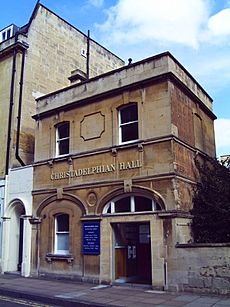
In 2021, the area of Bath and North East Somerset had a population of 193,400. Most people in the district are either non-religious or Christian.
The city of Bath itself had a population of 94,782 in 2011. Someone who lives in Bath is called a Bathonian.
Economy of Bath
Jobs and Industries
In the past, Bath had a lot of factories, making things like cranes, furniture, and even Plasticine! Companies like Stothert & Pitt were very important.
After World War II, many Ministry of Defence offices were in Bath. But these have moved away, and the sites are now being used for new homes.
Today, manufacturing isn't as big in Bath. Instead, the city has strong industries in software, publishing, and services. Rotork, an international manufacturing company, still has its main office here.
Tourism is a huge part of Bath's economy. Many jobs are related to visitors, like in hotels, restaurants, and shops. Other big job areas include education and health (like the National Health Service and universities), retail, and business services.
Bath is also a recognized center for publishing, with companies like Future plc employing many people. The city has over 400 shops, with half of them being unique independent stores. There are also about 100 restaurants and cafes.
Tourism in Bath
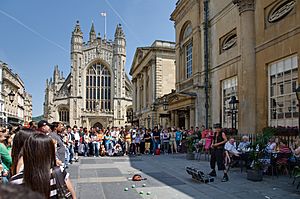
Tourism is one of Bath's main industries. Over one million people stay overnight in Bath each year, and 3.8 million visit for just one day. People come for the history and culture, especially since Bath is a World Heritage Site. You can see history from Roman times to the Georgian era.
There are almost 300 places to stay in Bath, including hotels and bed and breakfasts, many in beautiful Georgian buildings. The city also has about 100 restaurants and many pubs and bars.
You can take open top bus tours, walking tours, or river tours. Since the Thermae Bath Spa opened in 2006, visitors can once again bathe in the natural hot spring waters, just like people did centuries ago!
In 2010, the Royal Crescent was voted the second "Most Picturesque Street" in Britain. Milsom Street was named "Britain's Best Fashion Street."
Architecture of Bath
| City of Bath * | |
|---|---|
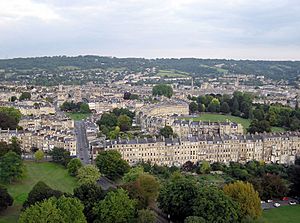 |
|
| Type | Cultural |
| Criteria | i, ii, iv |
| Reference | 428 |
| Region ** | Western Europe |
| Inscription history | |
| Inscription | 1987 (11th Session) |
|
|
You can find many Roman archaeological sites in the center of Bath. The baths are about 20 feet (6 meters) below today's street level. You can still see Roman foundations and parts of the baths. However, all the stone above the bath level was built much later.
Bath Abbey was originally a Norman church. The building you see today was built in the early 16th century. It has a late Perpendicular style with many windows (52 in total!) and beautiful fan vaulting on the ceiling.
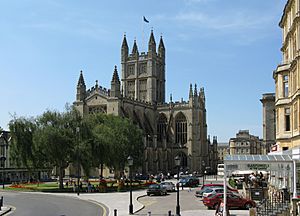
Most buildings in Bath are made from the local, golden-colored Bath Stone. Many of them were built in the 18th and 19th centuries. The main style is Georgian, which came from the Palladian style. Many famous architects helped design the city. What look like elegant homes were often lodging houses where visitors could rent rooms.
The Circus is made of three long, curved buildings designed by John Wood, the Elder. It forms a circular space meant for public events. The design was inspired by the Colosseum in Rome. Each floor has a different style of columns, becoming more fancy as you go up.
The Royal Crescent is one of Bath's most amazing buildings, built between 1767 and 1774 by John Wood, the Younger. It looks like one huge curved building with 30 houses, but it's not! Each person who bought a section hired their own architect to build a house behind the grand front. This means the back of the Crescent looks very different from the uniform front. Other beautiful curved streets include Lansdown Crescent.
Around 1770, the architect Robert Adam designed Pulteney Bridge. It's unique because it's not just a bridge over the Avon River, but also a shopping arcade! Like the Rialto Bridge in Venice, it's one of the few bridges in Europe that still has shops on it. It was named after Frances and William Pulteney, who owned the land on the other side of the river.
The heart of Georgian Bath was the Pump Room, designed by Thomas Baldwin. He also designed Great Pulteney Street, a wide boulevard over 1,000 feet (300 meters) long, lined with Georgian buildings.
In the 1960s and 1970s, some historic buildings in Bath were sadly replaced with modern ones. But a public campaign helped stop this. There's still discussion about new buildings, but Bath has kept its World Heritage Site status. UNESCO has asked the city to be careful with new developments and to aim for excellent modern architecture.
Culture and Fun in Bath
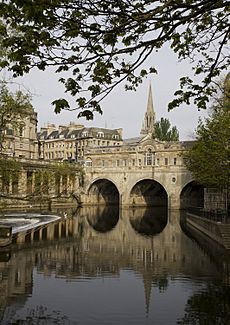
Bath became a center for fashionable life in England during the 18th century. This was when places like the Old Orchard Street Theatre and famous buildings like the Royal Crescent and Pulteney Bridge were built.
Bath has five theatres that host international shows. The city also has a strong musical tradition. Bath Abbey is the largest concert venue, holding many concerts and organ recitals each year. The city hosts annual events like the Bath International Music Festival, Bath Literature Festival (and one for children!), and the Bath Film Festival.
You can visit the Victoria Art Gallery, the Museum of East Asian Art, and the Holburne Museum. There are also many other museums, including the Fashion Museum, the Jane Austen Centre, and the Roman Baths. The Bath Royal Literary and Scientific Institution (BRLSI) has a long history of learning and science.
Arts and Famous People
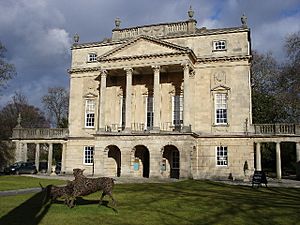
Artists like Thomas Gainsborough lived and worked in Bath in the 18th century.
Jane Austen, a famous writer, lived in Bath from 1801 to 1806. She didn't always love the city, but she set two of her novels, Northanger Abbey and Persuasion, in Bath. The city has a Jane Austen Centre and a city walk in her honor.
William Friese-Greene experimented with early movie camera technology in Bath in the 1870s. He is considered one of the inventors of cinematography.
Many films and TV shows have used Bath's beautiful buildings as a backdrop. These include Vanity Fair (2004) and The Duchess (2008). In 2012, Pulteney Weir was even used for stunt shots in the movie Les Misérables. The TV show McDonald & Dodds is also set and filmed in Bath.
In 2008, 104 decorated pig sculptures were displayed around the city in an art event called "King Bladud's Pigs in Bath." They were later auctioned to raise money for charity.
Parks and Green Spaces
Royal Victoria Park is a large park near the city center. It was opened in 1830 by the 11-year-old Queen Victoria and was the first park named after her. It has a skatepark, tennis courts, a golf course, and a children's play area. The park also has beautiful botanical gardens with many different plants. A replica Roman Temple, originally built for an exhibition in 1924, was moved and rebuilt in Victoria Park.
Other parks in Bath include Alexandra Park, Parade Gardens, and Sydney Gardens. Jane Austen once wrote that it would be nice to live near Sydney Gardens. Cleveland Pools, built around 1815, are the oldest surviving public outdoor lido (swimming pool) in England. They reopened in 2023 after a long restoration project.
Queen Victoria's Connection
The Victoria Art Gallery and Royal Victoria Park are named after Queen Victoria. She visited Bath and wrote in her journal that the people were "really too kind to me."
Bath's Special Foods
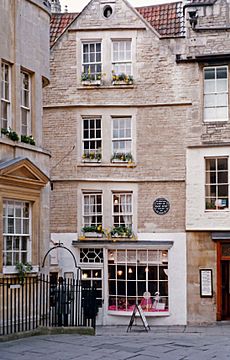
Bath is known for a few special foods:
- Sally Lunn buns: These are a type of sweet bread, like a large teacake. They were first mentioned in 1772 and can be eaten with sweet or savory toppings.
- Bath buns: These are smaller, round, very sweet, and rich buns. They used to have crushed caraway seeds on top.
- Bath Olivers: These are dry, baked biscuits invented by Dr. William Oliver in 1740.
- Bath chaps: This is a local dish made from salted and smoked pig's cheek and jawbones.
Bath also has its own breweries, Bath Ales and Abbey Ales.
Twin Cities
Bath is "twinned" with four other cities in Europe. This means they have a special friendship and cultural exchange.
- Aix-en-Provence, France
- Alkmaar, Netherlands
- Braunschweig, Germany
- Kaposvár, Hungary
Bath also has connections with Manly, New South Wales, Australia, and Beppu, Japan.
Education in Bath
Bath has two universities:
- The University of Bath: Started in 1966, it was named University of the Year in 2011. It offers courses in subjects like politics, languages, science, engineering, and architecture.
- Bath Spa University: This university offers courses in art and design, education, English, history, music, and science.
Bath College offers other types of further education. Norland College is famous for training nannies and childcare professionals.
Sports in Bath
Rugby
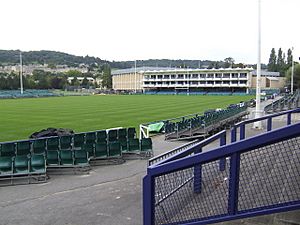
Bath Rugby is a professional rugby union team that plays in the top English league. They play at the Recreation Ground in the city. The team was founded in 1865. They have won many titles, including the John Player Cup multiple times and the Heineken Cup in 1998. Many players from Bath Rugby have also played for the English national team.
Football
Bath City F.C. is the city's semi-professional football team. They were founded in 1889 and play their home matches at Twerton Park. Bath City has a good history in the FA Cup, reaching the third round six times. Their record attendance at a game was 18,020 in 1960. The team's colors are black and white, and their nickname is "The Romans" because of Bath's Roman history.
There are also other local football clubs like Odd Down F.C. and Larkhall Athletic F.C..
Other Sports
Bath has several cricket clubs, including Bath Cricket Club. Cricket is also played at the Recreation Ground. The Bath Half Marathon is a big annual running event through the city streets, with over 10,000 runners.
TeamBath is the name for all the sports teams at the University of Bath. They are known for sports like athletics, badminton, basketball, hockey, judo, swimming, and tennis. The City of Bath Triathlon is held at the university every year.
Bath Roller Derby Girls is a roller derby club founded in 2012.
Getting Around Bath
Roads
Bath is about 11 miles (18 km) southeast of Bristol, connected by the A4 road. To reduce car use, Bath has "park and ride" schemes where you can park your car outside the city and take a bus in.
In 2021, Bath introduced a Clean Air Zone in the city center. This means that older, more polluting commercial vehicles have to pay a charge to enter the zone. This has helped reduce air pollution in the city.
Buses
National Express coaches run services from Bath bus station to other cities. First West of England operates a network of bus routes within Bath and to nearby towns like Bristol and Chippenham. The Bath Bus Company offers open-top bus tours and services to Bristol Airport.
Cycling
Bath is on National Cycle Route 4. You can cycle on the Bristol and Bath Railway Path to the west, which was one of Britain's first cycleways. There's also an eastern route towards London along the canal towpath.
Rivers and Canals
The River Avon connects Bath to Bristol and the sea. You can travel on the river using small boats through locks. The river is also connected to the River Thames and London by the Kennet and Avon Canal, which was restored in the late 20th century and is now popular with narrowboat users.
Trains
Bath is served by Bath Spa railway station, which was designed by the famous engineer Isambard Kingdom Brunel. You can take trains from here to London Paddington, Bristol, Cardiff, and other cities. There's also a smaller station called Oldfield Park for local services.
Green Park Station used to be another train station in Bath. Its line, which went through tunnels and over the Mendips, was closed in 1966. Now, the old station building has shops and a market, and the old railway line has been turned into a walking and cycling path called the Two Tunnels Greenway.
Trams
Bath used to have horse-drawn trams in the late 19th century, which were replaced by electric trams in 1904. These trams covered about 18 miles (29 km) of routes around the city. The last tram ran in 1939.
There have been discussions about bringing trams back to Bath since 2005, to help with pollution and traffic. In 2017, the council started a study to see if a light rail or tram system would work in the city.
Media in Bath
Bath's local newspaper is the Bath Chronicle. It used to be a daily paper but became a weekly in 2007. Its website is now part of Somerset Live.
For television, Bath is served by BBC West and ITV West Country, both based in Bristol.
Radio stations broadcasting to Bath include BBC Radio Bristol (which has a studio in the city center), Greatest Hits Radio Bath & The South West, and Heart West. The University Radio Bath is a student radio station available on campus and online. In 2019, BA1 Radio, an online community radio station, was launched.
Images for kids
See also
 In Spanish: Bath para niños
In Spanish: Bath para niños



